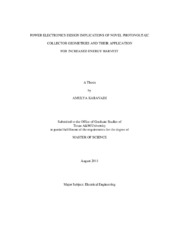| dc.contributor.advisor | Balog, Robert S. | |
| dc.creator | Karavadi, Amulya | |
| dc.date.accessioned | 2011-10-21T22:03:48Z | |
| dc.date.accessioned | 2011-10-22T07:12:08Z | |
| dc.date.available | 2011-10-21T22:03:48Z | |
| dc.date.available | 2011-10-22T07:12:08Z | |
| dc.date.created | 2011-08 | |
| dc.date.issued | 2011-10-21 | |
| dc.date.submitted | August 2011 | |
| dc.identifier.uri | https://hdl.handle.net/1969.1/ETD-TAMU-2011-08-9897 | |
| dc.description.abstract | The declining cost of photovoltaic (PV) modules has enabled the vision of ubiquitous photovoltaic (PV) power to become feasible. Emerging PV technologies are facilitating the creation of intentionally non-flat PV modules, which create new applications for this sustainable energy generation currently not possible with the traditional rigid, flat silicon-glass modules. However, since the photovoltaic cells are no longer coplanar, there are significant new requirements for the power electronics necessary to convert the native form of electricity into a usable form and ensure maximum energy harvest. Non-uniform insolation from cell-to-cell gives rise to non-uniform current density in the PV material, which limits the ability to create series-connected cells without bypass diode or other ways to shunt current, which is well known in the maximum power tracking literature. This thesis presents a modeling approach to determine and quantify the variations in generation of energy due to intentionally non-flat PV geometries. This will enable the power electronics circuitry to be optimized to harvest maximum energy from PV pixel elements – clusters of PV cells with similar operating characteristics.
This thesis systematically compares different geometries with identical two-dimensional projection "footprints" for energy harvest throughout the day. The results show that for the same footprint, a semi-cylindrical surface harvests more energy over a typical day than a flat plate. The modeling approach is then extended to demonstrate that by using non flat geometries for PV panel, the availability of a remotely located stand-alone power system can be increased when compared to a flat panel of same footprint. These results have broad application to a variety of energy scavenging scenarios in which either total energy harvested needs to be maximized or unusual geometries for the PV active surfaces are required, including building-integrated PV. This thesis develops the analysis of the potential energy harvest gain for advanced non-planar PV collectors as a necessary first step towards the design of the power electronics circuits and control algorithms to take advantage of the new opportunities of conformal and non-flat PV collectors. | en |
| dc.format.mimetype | application/pdf | |
| dc.language.iso | en_US | |
| dc.subject | Third generation Photovoltaics | en |
| dc.subject | Power electronic design implications | en |
| dc.subject | Increased energy harvest, solar energy, power electronics, energy harvest, maximum power point tracking, photovoltaic energy system, conformal photovoltaic, flexible photovoltaic | en |
| dc.title | Power Electronics Design Implications of Novel Photovoltaic Collector Geometries and Their Application for Increased Energy Harvest | en |
| dc.type | Thesis | en |
| thesis.degree.department | Electrical and Computer Engineering | en |
| thesis.degree.discipline | Electrical Engineering | en |
| thesis.degree.grantor | Texas A&M University | en |
| thesis.degree.name | Master of Science | en |
| thesis.degree.level | Masters | en |
| dc.contributor.committeeMember | Enjeti, Prasad | |
| dc.contributor.committeeMember | Wang, Haiyan | |
| dc.contributor.committeeMember | Vaddiraju, Sreeram | |
| dc.type.genre | thesis | en |
| dc.type.material | text | en |


